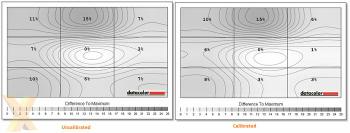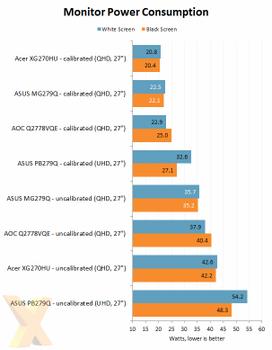Performance - Part II
Brightness and contrast
Brightness and contrast figures are quite typical of a high-quality IPS panel; 800:1 in real-world testing, and the monitor delivers on its maximum rated brightness of 350 nits. The factory default white point was quite cool, approximately 7600K, which is a lot cooler than a normal monitor white point of 6500K. Even more interesting is that the 'Normal' colour temperature preset actually pushes the Kelvin number up even higher to 8100K, so we'd like to see 6500K in future as the normal and default preset.
Brightness uniformity happened to be less impressive than colour uniformity, with brightness variations as high as 15 per cent. The bright spots aren't easily perceivable and users are more likely to pick up on IPS glow than brightness variations.
Input latency
For an IPS panel the MG279Q delivers a response time which matches the AOC Q2778VQE and Acer XG270HU, both of whom are TN-based QHD panels. In short, the MG279Q is an impressive panel for gamers, yet there are still faster panels out there (the ROG Swift, for example) but 24 milliseconds of total processing time is a solid result.
Power consumption
With a default brightness of 90 per cent the MG279Q consumes about 35-watts and that can be further lowered to 22-watts by calibrating down to an indoor-optimised brightness level of 120 nits. These numbers make the MG279Q a highly-efficient monitor, and even a triple-monitor setup would keep within a 100-watt envelope.






